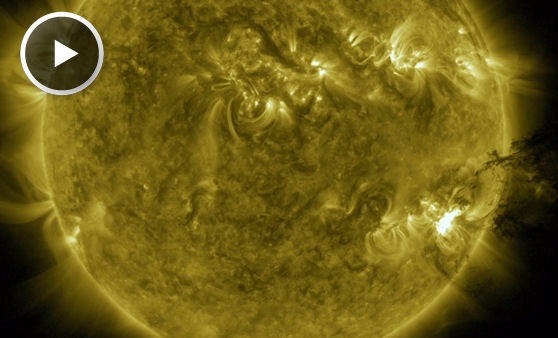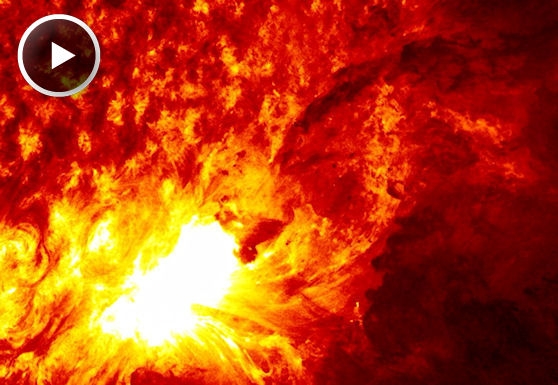Solar tsunami and dark fireworks on the Sun

On June 7, 2011, Earth-orbiting satellites detected a flash of X-rays coming from the western edge of the solar disk. Registering only “M” (for medium) on the Richter scale of solar flares, the blast at first appeared to be a run-of-the-mill eruption- that is, until researchers looked at the movies.
“We’d never seen anything like it,” says Alex Young, a solar physicist at the Goddard Space Flight Center. “Half of the sun appeared to be blowing itself to bits.”
NASA has just released new high-resolution videos of the event recorded by the Solar Dynamics Observatory (SDO). The videos are large, typically 50 MB to 100 MB, but worth the wait to download.

“In terms of raw power, this really was just a medium-sized eruption,” says Young, “but it had a uniquely dramatic appearance caused by all the inky-dark material. We don’t usually see that.“
The blast was triggered by an unstable magnetic filament near the sun’s surface. That filament was loaded down with cool plasma, which exploded in a spray of dark blobs and streamers. The plasma blobs were as big as planets, many larger than Earth. They rose and fell ballistically, moving under the influence of the sun’s gravity like balls tossed in the air, exploding “like bombs” when they hit the stellar surface.
SDO also detected a shadowy shock wave issuing from the blast site. The ‘solar tsunami’ propagated more than halfway across the sun, visibly shaking filaments and loops of magnetism en route.
Long-range action has become a key theme of solar physics since SDO was launched in 2010. The observatory frequently sees explosions in one part of the sun affecting other parts. Sometimes one explosion will trigger another … and another … with a domino sequence of flares going off all around the star.
The blast also propelled a significant coronal mass ejection (CME) out of the sun’s atmosphere.
It’s estimated that the cloud massed about 4.5 x1015 grams, placing it in the top 5% of all CMEs recorded in the Space Age. For comparison, the most massive CME ever recorded was 1016 grams, only a factor of ~2 greater than the June 7th cloud. The amount of material that fell back to the sun on June 7th was approximately equal to the amount that flew away.
Before SDO, space-based observatories observed the sun with relatively slow cadences and/or limited fields of view. They could have easily missed the majesty of such an explosion, catching only a single off-center snapshot at the beginning or end of the blast to hint at what actually happened. (Science.NASA)
Author: Dr. Tony Phillips | Credit: Science@NASA


Tims Solar Systems commented on The Watchers:
It?s actually a great and helpful piece of information. I?m glad that you just shared this helpful info with us. Please stay us up to date like this. Thank you for sharing.